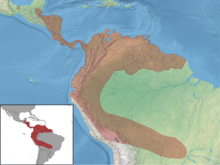Vampyrum
| Spectral bat | |
|---|---|
 |
|
| Scientific classification | |
| Kingdom: | Animalia |
| Phylum: | Chordata |
| Class: | Mammalia |
| Order: | Chiroptera |
| Family: | Phyllostomidae |
| Genus: |
Vampyrum Rafinesque, 1815 |
| Species: | V. spectrum |
| Binomial name | |
|
Vampyrum spectrum (Linnaeus, 1758) |
|
 |
|
The genus Vampyrum contains only one species, the spectral bat (Vampyrum spectrum). Some alternate names for this species are the false vampire bat, Linnaeus's false vampire bat and the spectral vampire bat. Confusingly, they are not related to the Old World family of large carnivorous bats to be found in the Megadermatidae that are also called false vampires.
This species is the largest bat (Chiroptera) native to the New World and the largest carnivorous bat in the world. The wingspan typically ranges from 60 to 91.5 cm (23.6 to 36.0 in), with the largest specimens attaining just over 100 cm (39 in). The length is 12.5–13.5 cm (4.9–5.3 in) (there is no tail) and body mass is 145–190 g (5.1–6.7 oz). The fur on the upper parts of the bat is normally dark brown, chestnut brown or rust-orange and quite short and fine. The ears are very long and rounded. There is no discernible tail, but the tail membrane is long and broad. The large feet are robust, with long curved claws. The muzzle is long and narrow, and the teeth are strong. The noseleaf, averaging 1.7 cm (0.67 in) long, is medium-sized, lance-shaped, horseshoe and spear with continuous rim raised to form a hollow cup around the nostrils. Underparts are usually pale, dirty gray-brown to yellow-brown – the fur is much shorter than on the front.
The range of the species is southern Mexico to Peru and Ecuador to central and northern Brazil, Suriname, Guyana, and the island of Trinidad. These bats are typically found roosting, usually on tree branches, but sometimes in hollow trees or even man-made structures, in dense, lowland neotropical forests, below an elevation of 1,650 m (5,410 ft). They are found in the greatest numbers in riparian areas. While foraging, they visit more diverse habitats and can be found in moist, evergreen forest, yards, secondary growth woodlands, forest edges, and muggy areas.
Skeleton
Study skin
Skull
Skull
The spectral bat is a formidable aerial night hunter. While true vampire bats, for which it was formerly named, parasitically feed on the blood of larger animals, often as they sleep and usually with little ill effect, this species rather actively hunts and kills other animals. This large predatory species primarily lives on relatively large vertebrate prey, such as small birds, small mammals (including other species of bats) and occasionally amphibians and reptiles. Prey usually lives or gathers in groups, has a strong odor and typically roosts on branches rather than in cavities. Most prey selected weighs from 20 to 150 g (0.71 to 5.29 oz), which is equal to their own weight. The remains of 84 bird specimens of 18 different species, including motmots, doves, trogons, cuckoos, wrens and orioles, were discovered at one spectral bat roost.Insects are also included in the diet, especially large crickets, cicadas, etc.
...
Wikipedia

